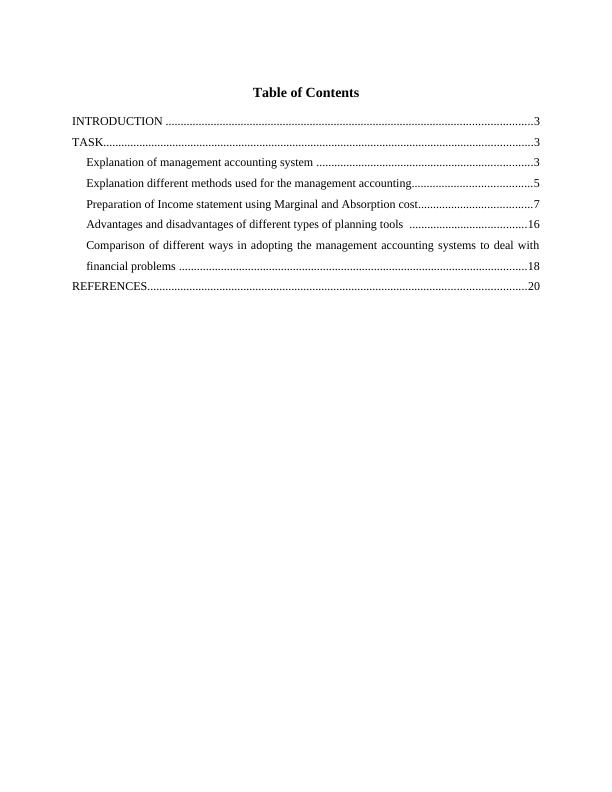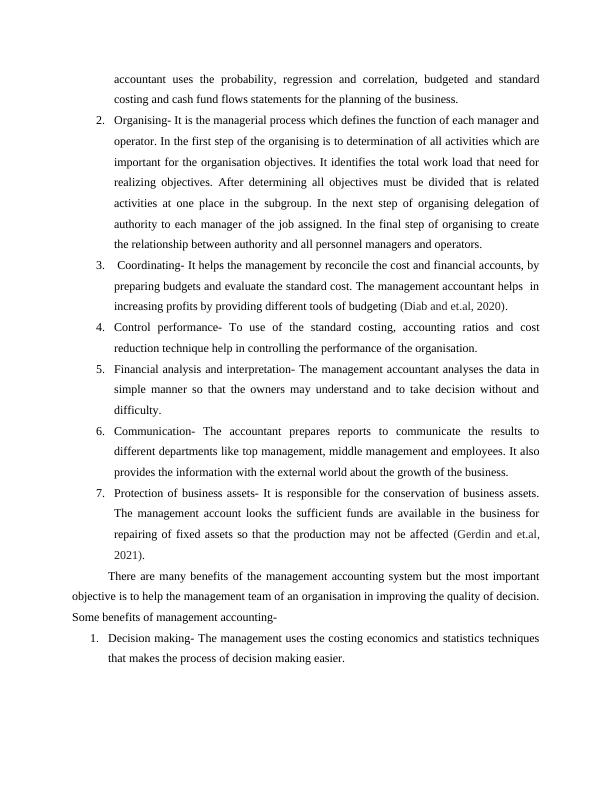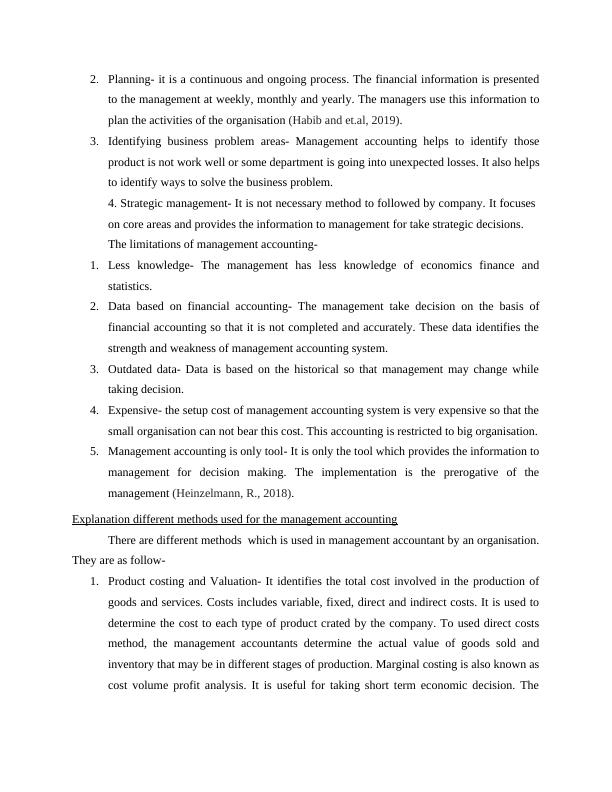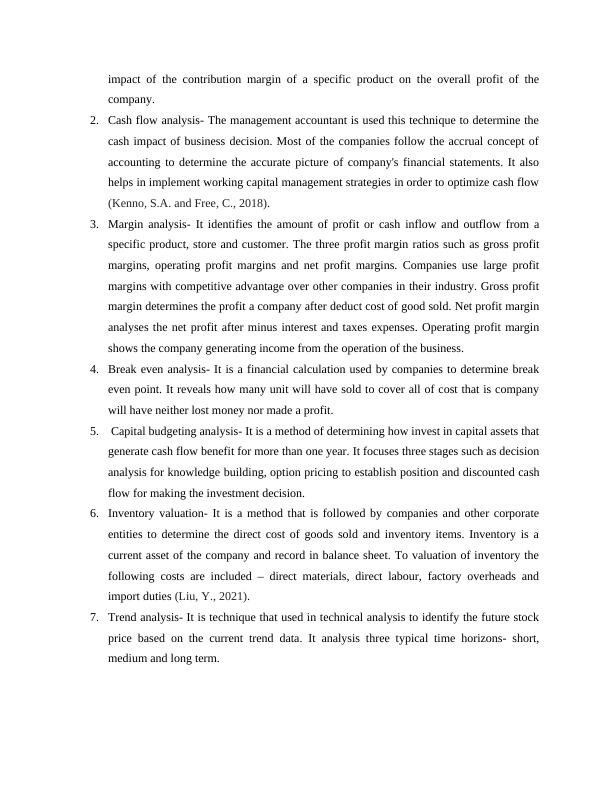Management Accounting: Explanation, Methods, and Planning Tools
Added on 2023-06-08
23 Pages4392 Words281 Views
MANAGEMENT
ACCOUNTING
ACCOUNTING

Table of Contents
INTRODUCTION ..........................................................................................................................3
TASK...............................................................................................................................................3
Explanation of management accounting system ........................................................................3
Explanation different methods used for the management accounting........................................5
Preparation of Income statement using Marginal and Absorption cost......................................7
Advantages and disadvantages of different types of planning tools .......................................16
Comparison of different ways in adopting the management accounting systems to deal with
financial problems ....................................................................................................................18
REFERENCES..............................................................................................................................20
INTRODUCTION ..........................................................................................................................3
TASK...............................................................................................................................................3
Explanation of management accounting system ........................................................................3
Explanation different methods used for the management accounting........................................5
Preparation of Income statement using Marginal and Absorption cost......................................7
Advantages and disadvantages of different types of planning tools .......................................16
Comparison of different ways in adopting the management accounting systems to deal with
financial problems ....................................................................................................................18
REFERENCES..............................................................................................................................20

INTRODUCTION
Management accounting is the application of the principles of accounting and financial
management to create, protect and increase value of the investors of for-profit-oriented
organisation and not- profit- oriented organisation. It is the integral part of management function.
It provides information to management for planning, controlling and decision making. It is wider
in scope because it includes financial accounting, budgeting, taxation and planning. It focuses
with the projection of figures for future. It does not contain any rules and regulations. It helps in
divide of the cost of products and inventories for both external and internal users. It is also
known as managerial accounting (Alsaid and et.al, 2020). The person is set up an information
system environment is known as Management Information System. In this report, explain the
management accounting , different types of management accounting system and different
methods used for management accounting report. Further it also includes the techniques to
calculate cost to prepare income statement using marginal and absorption costs, advantage and
disadvantage of budgetary control and compare how organisations are adapting management
accounting system (Bakhodirovna, A.N., 2019).
TASK
Explanation of management accounting system
The accounting is used as a tool in analysing the business activities. Accounting
information is presented in different ways. There are two types of accounting provides the
information such as financial accounting and management accounting. In this report discuss the
management accounting. It is the process of providing information to the managers in decision
making. It gives special consideration on the internal team of the organisation. The main
objective is to use the data analysis and take a better decision. Management accounting includes
many aspects of accounting. It focuses at improving the quality of information relating to the
cost and sales revenue of goods and services of the company. Management accountants work in
both public and private sectors. It gives the information both monetary and non monetary (Burritt
and et.al, 2021). There are many functions of the management accounting but the main functions
are as follow-
1. forecasting- It plays an important role in management accounting. Its objective is to
provide the information for making short term and long term decision. The management
Management accounting is the application of the principles of accounting and financial
management to create, protect and increase value of the investors of for-profit-oriented
organisation and not- profit- oriented organisation. It is the integral part of management function.
It provides information to management for planning, controlling and decision making. It is wider
in scope because it includes financial accounting, budgeting, taxation and planning. It focuses
with the projection of figures for future. It does not contain any rules and regulations. It helps in
divide of the cost of products and inventories for both external and internal users. It is also
known as managerial accounting (Alsaid and et.al, 2020). The person is set up an information
system environment is known as Management Information System. In this report, explain the
management accounting , different types of management accounting system and different
methods used for management accounting report. Further it also includes the techniques to
calculate cost to prepare income statement using marginal and absorption costs, advantage and
disadvantage of budgetary control and compare how organisations are adapting management
accounting system (Bakhodirovna, A.N., 2019).
TASK
Explanation of management accounting system
The accounting is used as a tool in analysing the business activities. Accounting
information is presented in different ways. There are two types of accounting provides the
information such as financial accounting and management accounting. In this report discuss the
management accounting. It is the process of providing information to the managers in decision
making. It gives special consideration on the internal team of the organisation. The main
objective is to use the data analysis and take a better decision. Management accounting includes
many aspects of accounting. It focuses at improving the quality of information relating to the
cost and sales revenue of goods and services of the company. Management accountants work in
both public and private sectors. It gives the information both monetary and non monetary (Burritt
and et.al, 2021). There are many functions of the management accounting but the main functions
are as follow-
1. forecasting- It plays an important role in management accounting. Its objective is to
provide the information for making short term and long term decision. The management

accountant uses the probability, regression and correlation, budgeted and standard
costing and cash fund flows statements for the planning of the business.
2. Organising- It is the managerial process which defines the function of each manager and
operator. In the first step of the organising is to determination of all activities which are
important for the organisation objectives. It identifies the total work load that need for
realizing objectives. After determining all objectives must be divided that is related
activities at one place in the subgroup. In the next step of organising delegation of
authority to each manager of the job assigned. In the final step of organising to create
the relationship between authority and all personnel managers and operators.
3. Coordinating- It helps the management by reconcile the cost and financial accounts, by
preparing budgets and evaluate the standard cost. The management accountant helps in
increasing profits by providing different tools of budgeting (Diab and et.al, 2020).
4. Control performance- To use of the standard costing, accounting ratios and cost
reduction technique help in controlling the performance of the organisation.
5. Financial analysis and interpretation- The management accountant analyses the data in
simple manner so that the owners may understand and to take decision without and
difficulty.
6. Communication- The accountant prepares reports to communicate the results to
different departments like top management, middle management and employees. It also
provides the information with the external world about the growth of the business.
7. Protection of business assets- It is responsible for the conservation of business assets.
The management account looks the sufficient funds are available in the business for
repairing of fixed assets so that the production may not be affected (Gerdin and et.al,
2021).
There are many benefits of the management accounting system but the most important
objective is to help the management team of an organisation in improving the quality of decision.
Some benefits of management accounting-
1. Decision making- The management uses the costing economics and statistics techniques
that makes the process of decision making easier.
costing and cash fund flows statements for the planning of the business.
2. Organising- It is the managerial process which defines the function of each manager and
operator. In the first step of the organising is to determination of all activities which are
important for the organisation objectives. It identifies the total work load that need for
realizing objectives. After determining all objectives must be divided that is related
activities at one place in the subgroup. In the next step of organising delegation of
authority to each manager of the job assigned. In the final step of organising to create
the relationship between authority and all personnel managers and operators.
3. Coordinating- It helps the management by reconcile the cost and financial accounts, by
preparing budgets and evaluate the standard cost. The management accountant helps in
increasing profits by providing different tools of budgeting (Diab and et.al, 2020).
4. Control performance- To use of the standard costing, accounting ratios and cost
reduction technique help in controlling the performance of the organisation.
5. Financial analysis and interpretation- The management accountant analyses the data in
simple manner so that the owners may understand and to take decision without and
difficulty.
6. Communication- The accountant prepares reports to communicate the results to
different departments like top management, middle management and employees. It also
provides the information with the external world about the growth of the business.
7. Protection of business assets- It is responsible for the conservation of business assets.
The management account looks the sufficient funds are available in the business for
repairing of fixed assets so that the production may not be affected (Gerdin and et.al,
2021).
There are many benefits of the management accounting system but the most important
objective is to help the management team of an organisation in improving the quality of decision.
Some benefits of management accounting-
1. Decision making- The management uses the costing economics and statistics techniques
that makes the process of decision making easier.

2. Planning- it is a continuous and ongoing process. The financial information is presented
to the management at weekly, monthly and yearly. The managers use this information to
plan the activities of the organisation (Habib and et.al, 2019).
3. Identifying business problem areas- Management accounting helps to identify those
product is not work well or some department is going into unexpected losses. It also helps
to identify ways to solve the business problem.
4. Strategic management- It is not necessary method to followed by company. It focuses
on core areas and provides the information to management for take strategic decisions.
The limitations of management accounting-
1. Less knowledge- The management has less knowledge of economics finance and
statistics.
2. Data based on financial accounting- The management take decision on the basis of
financial accounting so that it is not completed and accurately. These data identifies the
strength and weakness of management accounting system.
3. Outdated data- Data is based on the historical so that management may change while
taking decision.
4. Expensive- the setup cost of management accounting system is very expensive so that the
small organisation can not bear this cost. This accounting is restricted to big organisation.
5. Management accounting is only tool- It is only the tool which provides the information to
management for decision making. The implementation is the prerogative of the
management (Heinzelmann, R., 2018).
Explanation different methods used for the management accounting
There are different methods which is used in management accountant by an organisation.
They are as follow-
1. Product costing and Valuation- It identifies the total cost involved in the production of
goods and services. Costs includes variable, fixed, direct and indirect costs. It is used to
determine the cost to each type of product crated by the company. To used direct costs
method, the management accountants determine the actual value of goods sold and
inventory that may be in different stages of production. Marginal costing is also known as
cost volume profit analysis. It is useful for taking short term economic decision. The
to the management at weekly, monthly and yearly. The managers use this information to
plan the activities of the organisation (Habib and et.al, 2019).
3. Identifying business problem areas- Management accounting helps to identify those
product is not work well or some department is going into unexpected losses. It also helps
to identify ways to solve the business problem.
4. Strategic management- It is not necessary method to followed by company. It focuses
on core areas and provides the information to management for take strategic decisions.
The limitations of management accounting-
1. Less knowledge- The management has less knowledge of economics finance and
statistics.
2. Data based on financial accounting- The management take decision on the basis of
financial accounting so that it is not completed and accurately. These data identifies the
strength and weakness of management accounting system.
3. Outdated data- Data is based on the historical so that management may change while
taking decision.
4. Expensive- the setup cost of management accounting system is very expensive so that the
small organisation can not bear this cost. This accounting is restricted to big organisation.
5. Management accounting is only tool- It is only the tool which provides the information to
management for decision making. The implementation is the prerogative of the
management (Heinzelmann, R., 2018).
Explanation different methods used for the management accounting
There are different methods which is used in management accountant by an organisation.
They are as follow-
1. Product costing and Valuation- It identifies the total cost involved in the production of
goods and services. Costs includes variable, fixed, direct and indirect costs. It is used to
determine the cost to each type of product crated by the company. To used direct costs
method, the management accountants determine the actual value of goods sold and
inventory that may be in different stages of production. Marginal costing is also known as
cost volume profit analysis. It is useful for taking short term economic decision. The

impact of the contribution margin of a specific product on the overall profit of the
company.
2. Cash flow analysis- The management accountant is used this technique to determine the
cash impact of business decision. Most of the companies follow the accrual concept of
accounting to determine the accurate picture of company's financial statements. It also
helps in implement working capital management strategies in order to optimize cash flow
(Kenno, S.A. and Free, C., 2018).
3. Margin analysis- It identifies the amount of profit or cash inflow and outflow from a
specific product, store and customer. The three profit margin ratios such as gross profit
margins, operating profit margins and net profit margins. Companies use large profit
margins with competitive advantage over other companies in their industry. Gross profit
margin determines the profit a company after deduct cost of good sold. Net profit margin
analyses the net profit after minus interest and taxes expenses. Operating profit margin
shows the company generating income from the operation of the business.
4. Break even analysis- It is a financial calculation used by companies to determine break
even point. It reveals how many unit will have sold to cover all of cost that is company
will have neither lost money nor made a profit.
5. Capital budgeting analysis- It is a method of determining how invest in capital assets that
generate cash flow benefit for more than one year. It focuses three stages such as decision
analysis for knowledge building, option pricing to establish position and discounted cash
flow for making the investment decision.
6. Inventory valuation- It is a method that is followed by companies and other corporate
entities to determine the direct cost of goods sold and inventory items. Inventory is a
current asset of the company and record in balance sheet. To valuation of inventory the
following costs are included – direct materials, direct labour, factory overheads and
import duties (Liu, Y., 2021).
7. Trend analysis- It is technique that used in technical analysis to identify the future stock
price based on the current trend data. It analysis three typical time horizons- short,
medium and long term.
company.
2. Cash flow analysis- The management accountant is used this technique to determine the
cash impact of business decision. Most of the companies follow the accrual concept of
accounting to determine the accurate picture of company's financial statements. It also
helps in implement working capital management strategies in order to optimize cash flow
(Kenno, S.A. and Free, C., 2018).
3. Margin analysis- It identifies the amount of profit or cash inflow and outflow from a
specific product, store and customer. The three profit margin ratios such as gross profit
margins, operating profit margins and net profit margins. Companies use large profit
margins with competitive advantage over other companies in their industry. Gross profit
margin determines the profit a company after deduct cost of good sold. Net profit margin
analyses the net profit after minus interest and taxes expenses. Operating profit margin
shows the company generating income from the operation of the business.
4. Break even analysis- It is a financial calculation used by companies to determine break
even point. It reveals how many unit will have sold to cover all of cost that is company
will have neither lost money nor made a profit.
5. Capital budgeting analysis- It is a method of determining how invest in capital assets that
generate cash flow benefit for more than one year. It focuses three stages such as decision
analysis for knowledge building, option pricing to establish position and discounted cash
flow for making the investment decision.
6. Inventory valuation- It is a method that is followed by companies and other corporate
entities to determine the direct cost of goods sold and inventory items. Inventory is a
current asset of the company and record in balance sheet. To valuation of inventory the
following costs are included – direct materials, direct labour, factory overheads and
import duties (Liu, Y., 2021).
7. Trend analysis- It is technique that used in technical analysis to identify the future stock
price based on the current trend data. It analysis three typical time horizons- short,
medium and long term.

End of preview
Want to access all the pages? Upload your documents or become a member.
Related Documents
Management Accounting and Cost Analysis for Prime Furniturelg...
|17
|4788
|486
Compare how organizations are adapting management accounting systemslg...
|18
|4869
|620
Report on Aspects of Management Accounting : Tech Ltdlg...
|24
|6442
|54
Management Accounting(MA) Assignmentlg...
|13
|3590
|186
LO 1 5 P1. Explaining management accounting and essential requirementslg...
|18
|4484
|236
Management Accounting Assignment Solved (Doc)lg...
|18
|5370
|87